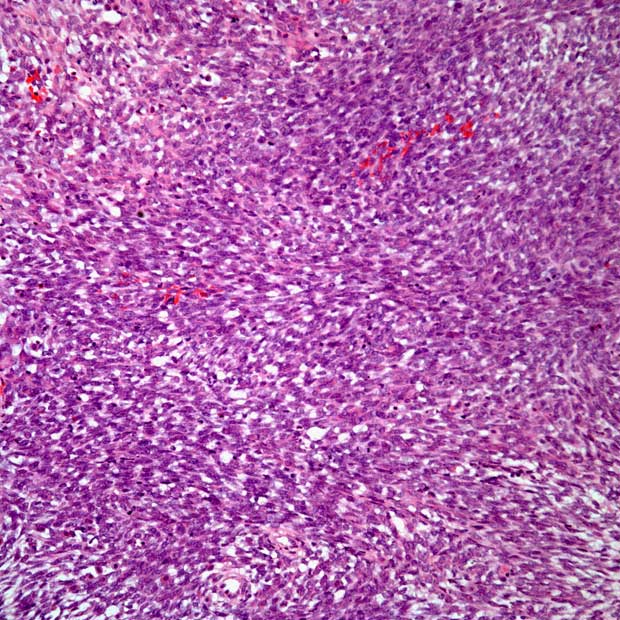Atezolizumab Combo Significantly Improves Survival in Cervical Cancer
Combining atezolizumab with bevacizumab and chemotherapy may be a new frontline therapy option for patients with metastatic, persistent or recurrent cervical cancer, says Ana Oaknin, MD, PhD.
“Atezolizumab in combination with bevacizumab added to platinum-based chemotherapy should be considered a new first-line therapy option for patients with metastatic, persistent, or recurrent cervical cancer,” according to Ana Oaknin, MD, PhD.

Adding atezolizumab (Tecentriq) to bevacizumab (Avastin) and platinum-based chemotherapy elicited clinically meaningful and statistically significant improvements in progression-free survival (PFS) and overall survival (OS) compared with bevacizumab plus chemotherapy in metastatic, persistent or recurrent cervical cancer, according to findings from the phase 3 BEATcc trial (NCT03556839) presented at the 2023 Annual Global Meeting of the International Gynecologic Cancer Society (IGCS).
With a median follow-up of 32.9 months (95% CI, 31.2-34.6), the median PFS was 13.7 months (95% CI, 12.3-16.6) with atezolizumab plus bevacizumab and chemotherapy vs 10.4 months (95% CI, 9.7-11.7) with bevacizumab plus chemotherapy (HR, 0.62; 95% CI, 0.49-0.78; P <.0001). In each respective arm, the PFS rate was 58% vs 42% at 12 months, 36% vs 19% at 24 months, and 26% vs 12% at 36 months.
In the interim analysis for OS, the median OS for patients receiving the atezolizumab-based regimen was 32.1 months (95% CI, 25.3-36.8) compared with 22.8 months (95% CI, 20.3-28.0) for those who received bevacizumab plus chemotherapy (HR, 0.68; 95% CI, 0.52-0.88; P = .0046). The 12-month, 24-month, and 36-month OS rates in each arm, respectively, were 84% vs 80%, 61% vs 49%, and 42% vs 26%.
The objective response rate was reported to be 84% (95% CI, 79%-89%) in the atezolizumab arm, which included a partial response (PR) rate of 52% and a complete response (CR) rate of 32%. The ORR for patients receiving bevacizumab plus chemotherapy alone was 72% (95% CI, 66%-78%), with 52% and 20% of patients achieving PRs and CRs, respectively.
Data indicated a median duration of response (DOR) of 13.6 months (95% CI, 10.6-21.3) with the atezolizumab regimen vs 8.6 months (95% CI, 8.0-10.6) with bevacizumab plus chemotherapy (HR, 0.60; 95% CI, 0.46-0.78). Ongoing responses in each respective arm were observed in 54% vs 35% of patients at 12 months, 40% vs 19% at 24 months, and 29% vs 16% at 36 months.
“Atezolizumab in combination with bevacizumab added to platinum-based chemotherapy should be considered a new first-line therapy option for patients with metastatic, persistent, or recurrent cervical cancer,” Ana Oaknin, MD, PhD, head of the Gynecologic Cancer Program at Vall d’Hebron Institute of Oncology, Hospital Universitari Vall d’Hebron, Vall d’Hebron Barcelona Hospital Campus at Barcelona, Spain, said in a presentation.
In the open-label BEATcc trial, 410 patients were randomly assigned 1:1 to receive 15 mg/kg of bevacizumab plus paclitaxel and cisplatin/carboplatin with or without 1200 mg of atezolizumab. All agents were administered intravenously every 3 weeks.
The trial’s dual primary end points were PFS per investigator assessment based on RECIST v1.1 criteria and OS. Key secondary end points included ORR and DOR.
Patients with metastatic, persistent, or recurrent cervical cancer not amenable to curative therapy and an ECOG performance status of 0 or 1 were able to enroll on the trial. Other eligibility criteria included having no prior systemic anti-cancer treatment and available tumor samples for PD-L1 expression. Patients with pelvic disease were eligible if they had no bladder or rectal mucosa involvement. Investigators stratified patients based on prior concurrent chemoradiation, histology, and chemotherapy.
Any-grade adverse effects (AEs) occurred in 99% of patients in the atezolizumab arm and 99% of those in the non-atezolizumab arm, and grade 3 or higher toxicities affected 79% and 75% of each respective group. AEs of special interest for bevacizumab affected 51% and 50% of patients in each respective arm, and toxicities of special interest for atezolizumab occurred in 21% and 0%. Additionally, 15% and 16% of patients in each arm experienced AEs that resulted in any treatment discontinuation.
Oaknin concluded that the safety profile of atezolizumab plus bevacizumab and chemotherapy was predictable and manageable. Additionally, the regimen did not raise any new safety signals.
Reference
Oaknin A, Gladieff L, Martínez J, et al. Primary results from BEATcc (ENGOT-Cx10/GEICO 68-C/JGOG1084/GOG-3030), a randomized phase 3 trial of first-line atezolizumab combined with bevacizumab and a platinum doublet for metastatic (stage IVB), persistent or recurrent cervical cancer. Presented at 2023 Annual Global Meeting of the International Gynecologic Cancer Society; November 5-7, 2023; Seoul, Korea; abstract SE005/1615.